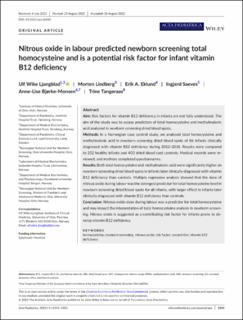| dc.contributor.author | Ljungblad, Ulf Wike | |
| dc.contributor.author | Lindberg, Morten | |
| dc.contributor.author | Eklund, Erik A. | |
| dc.contributor.author | Sæves, Ingjerd | |
| dc.contributor.author | Monsen, Anne-Lise Bjørke | |
| dc.contributor.author | Tangeraas, Trine | |
| dc.date.accessioned | 2023-05-10T10:05:31Z | |
| dc.date.available | 2023-05-10T10:05:31Z | |
| dc.date.created | 2022-08-31T08:05:55Z | |
| dc.date.issued | 2022 | |
| dc.identifier.citation | Acta Paediatrica. 2022, 111 (12), 2315-2321. | en_US |
| dc.identifier.issn | 0803-5253 | |
| dc.identifier.uri | https://hdl.handle.net/11250/3067457 | |
| dc.description.abstract | Aim: Risk factors for vitamin B12 deficiency in infants are not fully understood. The aim of the study was to assess predictors of total homocysteine and methylmalonic acid analysed in newborn screening dried blood spots. Methods: In a Norwegian case control study, we analysed total homocysteine and methylmalonic acid in newborn screening dried blood spots of 86 infants clinically diagnosed with vitamin B12 deficiency during 2012-2018. Results were compared to 252 healthy infants and 400 dried blood spot controls. Medical records were reviewed, and mothers completed questionnaires. Results: Both total homocysteine and methylmalonic acid were significantly higher on newborn screening dried blood spots in infants later clinically diagnosed with vitamin B12 deficiency than controls. Multiple regression analysis showed that the dose of nitrous oxide during labour was the strongest predictor for total homocysteine level in newborn screening dried blood spots for all infants, with larger effect in infants later clinically diagnosed with vitamin B12 deficiency than controls. Conclusion: Nitrous oxide dose during labour was a predictor for total homocysteine and may impact the interpretation of total homocysteine analysis in newborn screening. Nitrous oxide is suggested as a contributing risk factor for infants prone to develop vitamin B12 deficiency. This is an open access article under the terms of the Creative Commons Attribution-NonCommercial License, which permits use, distribution and reproduction in any medium, provided the original work is properly cited and is not used for commercial purposes. © 2022 The Authors. Acta Paediatrica published by John Wiley & Sons Ltd on behalf of Foundation Acta Paediatrica. | en_US |
| dc.description.abstract | Nitrous oxide in labour predicted newborn screening total homocysteine and is a potential risk factor for infant vitamin B12 deficiency | en_US |
| dc.language.iso | eng | en_US |
| dc.publisher | Wiley | en_US |
| dc.relation.uri | https://onlinelibrary.wiley.com/doi/10.1111/apa.16530 | |
| dc.rights | Navngivelse-Ikkekommersiell 4.0 Internasjonal | * |
| dc.rights.uri | http://creativecommons.org/licenses/by-nc/4.0/deed.no | * |
| dc.subject | homocysteine; | en_US |
| dc.subject | newborn screening; | en_US |
| dc.subject | nitrous oxide; | en_US |
| dc.subject | risk factor; | en_US |
| dc.subject | second-tier; | en_US |
| dc.subject | vitamin b12 deficiency. | en_US |
| dc.title | Nitrous oxide in labour predicted newborn screening total homocysteine and is a potential risk factor for infant vitamin B12 deficiency | en_US |
| dc.title.alternative | Nitrous oxide in labour predicted newborn screening total homocysteine and is a potential risk factor for infant vitamin B12 deficiency | en_US |
| dc.type | Peer reviewed | en_US |
| dc.type | Journal article | en_US |
| dc.description.version | publishedVersion | en_US |
| dc.rights.holder | © 2022 The Authors. | en_US |
| dc.source.pagenumber | 2315-2321 | en_US |
| dc.source.volume | 111 | en_US |
| dc.source.journal | Acta Paediatrica | en_US |
| dc.source.issue | 12 | en_US |
| dc.identifier.doi | 10.1111/apa.16530 | |
| dc.identifier.cristin | 2047401 | |
| cristin.ispublished | true | |
| cristin.fulltext | original | |
| cristin.qualitycode | 1 | |

